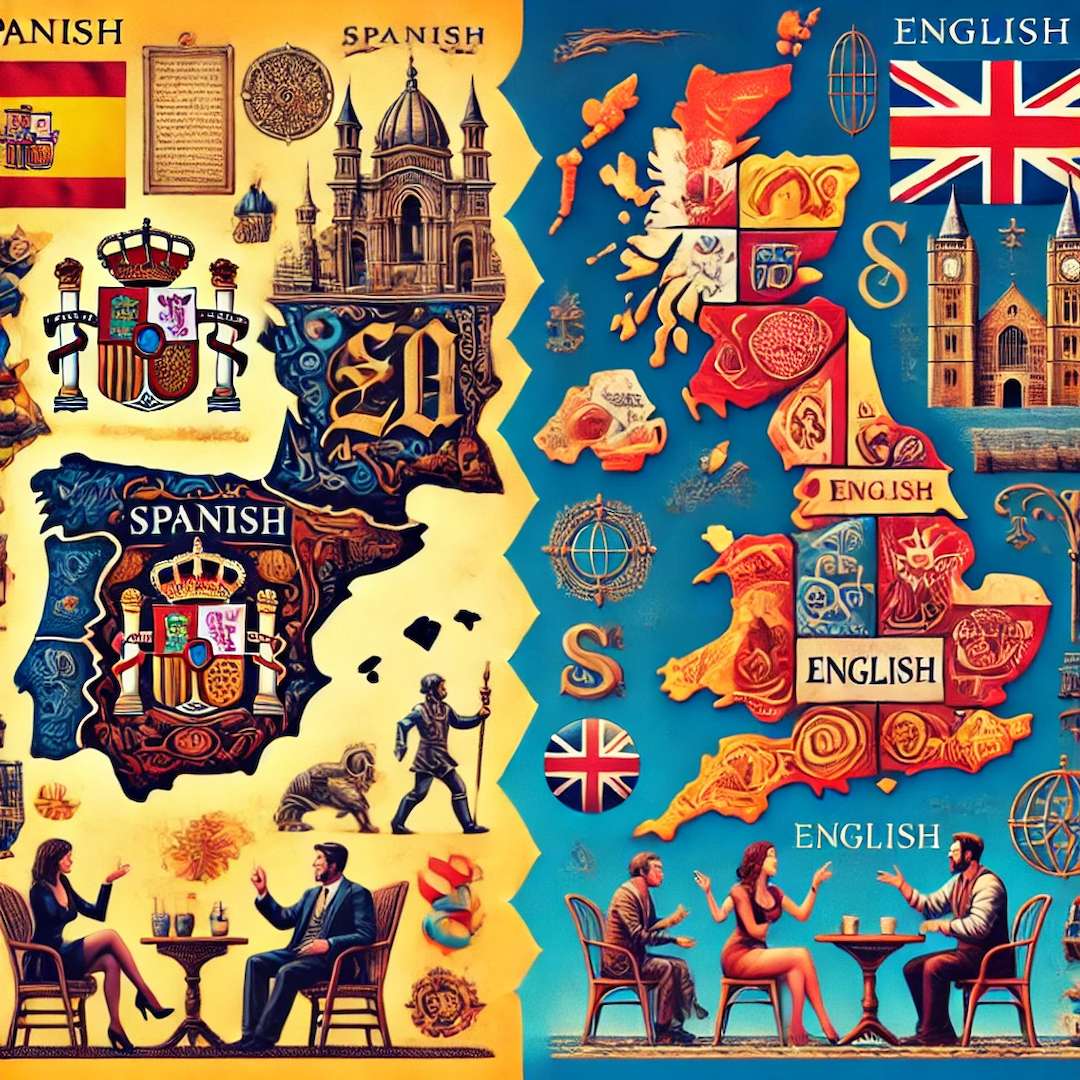Spanish vs English Language
Key Differences, History, and Fascinating Comparisons
- November 17, 2024
- By Tobias Woudt
When it comes to learning a new language, Spanish and English are two of the most widely spoken languages in the world.
English serves as a global lingua franca, while Spanish is the second most widely spoken native language.
Despite sharing some Latin roots, these two languages have evolved in distinct ways over time, resulting in unique grammatical rules, vocabulary, and cultural nuances.
Whether you’re a Spanish speaker learning English or vice versa, understanding the key differences and similarities between these languages can make the learning process much easier.

Table of Content
A Brief History of Spanish vs English Language
Origins of the Spanish Language
The Spanish language, or Español, originated in the Iberian Peninsula as a descendant of Latin, brought by the Romans during their occupation of Hispania (modern-day Spain and Portugal) beginning in 218 BC.
Over time, the spoken Latin evolved due to influences from indigenous Iberian languages, as well as later invasions and settlements by Germanic tribes (Visigoths) and the Moors (Arabs and Berbers). The Arabic influence was particularly significant, as the Moors ruled much of the Iberian Peninsula from 711 to 1492 AD, introducing thousands of Arabic loanwords into Spanish.
The Reconquista (the Christian reconquest of Iberia) led to the dominance of the Castilian dialect, which became the basis for modern Spanish. Following the Age of Exploration, Spanish spread globally, becoming the primary language in much of Latin America, parts of Africa, and even regions of Asia such as the Philippines.

Origins of the English Language
The English language is a Germanic language with origins in the languages of the Angles, Saxons, and Jutes—tribes who migrated to Britain from what is now Germany and Denmark around the 5th century AD. Early Old English was heavily influenced by Old Norse due to Viking invasions and settlements.
However, one of the most significant transformations of English came after the Norman Conquest of England in 1066, when the French-speaking Normans became the ruling class. This resulted in a significant infusion of French and Latin vocabulary, creating a linguistic blend that laid the groundwork for Middle English. By the time of the Renaissance, English continued to absorb words from other languages due to increased trade and exploration, evolving into Early Modern English as characterized by writers like Shakespeare.
Today, English is considered a global lingua franca and the dominant language of international communication, while Spanish is the second most spoken native language worldwide.

Spanish vs English Language: Key Differences Between Them
Phonetics and Pronunciation
One of the most striking differences between Spanish and English lies in their phonetic systems. Spanish is considered a phonetic language, meaning that most words are pronounced exactly as they are spelled. Once you learn the rules of pronunciation, you can generally read any Spanish word correctly. English, on the other hand, is not as consistent. Words like “through,” “though,” and “thought” are spelled similarly but pronounced differently, often confusing new learners.
Spanish also has five vowel sounds, compared to English’s twelve. This makes mastering vowel pronunciation easier for Spanish learners, but English learners may struggle with subtleties like the difference between “bit” and “beat.”
Grammar and Syntax
Verb Conjugation:
Spanish verbs are highly inflected and change forms to indicate tense, mood, person, and number. For example, the verb “hablar” (to speak) changes significantly depending on the subject (e.g., “yo hablo,” “tú hablas,” “él/ella habla”). In contrast, English relies on auxiliary verbs like “do” and “have” and maintains a simpler conjugation system (e.g., “I speak,” “you speak,” “he/she speaks”).
Noun Gender:
Spanish nouns have gender, and every noun is classified as either masculine or feminine. This affects the articles and adjectives that modify the noun. For example, “el gato negro” (the black cat) vs. “la gata negra” (the black cat). English nouns do not have grammatical gender, simplifying agreement between nouns and adjectives.
Articles and Adjectives:
In Spanish, adjectives usually follow the noun (e.g., “el coche rojo” – the red car), while in English, adjectives typically come before the noun (“the red car”). Additionally, Spanish articles vary by gender and number, while English articles remain mostly unchanged (the/a/an).
Word Order:
While English tends to follow a strict Subject-Verb-Object order, Spanish allows for more flexibility due to verb conjugation and context clues. For example, “Juan come una manzana” (Juan eats an apple) can sometimes be reordered in more conversational contexts.
Vocabulary and Cognates
Spanish and English share many cognates due to their Latin roots. Words like “university” and “universidad,” or “problem” and “problema,” bear a strong resemblance and are easily recognizable.
However, false cognates, or “false friends,” can create confusion.
For example, “embarrassed” in English might seem similar to “embarazada” in Spanish, but the latter means “pregnant,” not “embarrassed.”
List of Similar Words (Cognates)
Here are a few examples of similar words between Spanish and English:
1. Actor – Actor
2. Animal – Animal
3. Color – Color
4. Delicious – Delicioso
5. Doctor – Doctor/Doctora
6. Family – Familia
7. Hospital – Hospital
8. Idea – Idea
9. Important – Importante
10. Information – Información
11. Moment – Momento
12. Music – Música
13. Natural – Natural
14. Perfect – Perfecto
15. Telephone – Teléfono
Politeness and Formality
Spanish has formal and informal modes of address, reflected in pronouns and verb conjugation (e.g., “tú” vs. “usted”). In English, formality is usually conveyed through tone and context, rather than through specific pronouns or conjugations.
Idiomatic Expressions
Both languages have rich traditions of idiomatic expressions, but they rarely translate directly. For example, “Estar en las nubes” (to be in the clouds) means “to daydream” in English, while “It’s raining cats and dogs” in English means heavy rainfall.
Spanish vs English Language: Which Language is Easier to Learn?
This question depends largely on the learner’s native language, goals, and personal affinity for one or the other.
Generally, English speakers find Spanish grammar complex due to gendered nouns and verb conjugations, but the phonetic consistency can be easier.
Spanish speakers learning English may struggle with pronunciation, irregular verbs, and word order.
However, both languages open doors to rich cultures, careers, and cross-cultural communication.

Conclusion: Spanish vs English Language
Whether you’re learning Spanish or English, the journey is rewarding and challenging in its own unique way.
Mastering the differences and appreciating the similarities can help make the process more enjoyable. Embrace the grammar, dive into cultural nuances, and above all, practice speaking—because language is meant to bring people together.
Happy learning!
At the Tobian Language School, we are proud to offer courses in both English and Spanish to help you achieve your language goals.
Join us and start your journey today!

Tobias is a polyglot, traveller and founder of the Tobian Language School.
